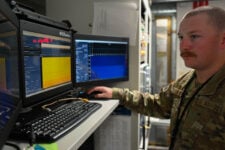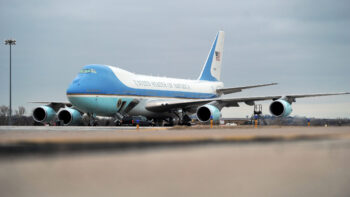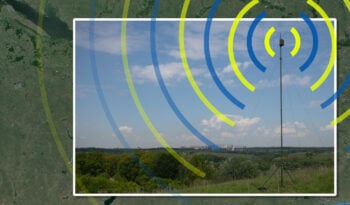
The Space Force’s Commercial Space Office intends to award $40 million in small grants to explore alternatives to GPS satellites for military positioning, navigation and timing. (US Army Photo by Sgt. Khalan Moore)
In March, the House’s Select Committee on the CCP raised questions about whether US phones should continue to access Chinese and Russian signals, or whether those constitute a security threat. In the following response, David Grossman of the Consumer Technology Association and Lisa Dyer of GPS Innovation Alliance offer their counterargument.
Americans rely on the Global Positioning System (GPS) when using rideshares, ordering delivery, tending to a farm, or heading out on a hike. Often working seamlessly in the background, this well-functioning system may be under threat — if policymakers citing vague ”security risks” undermine how US companies can compete in a global marketplace.
American companies have long been leaders in GPS-driven technology, and GPS itself is owned and operated by the US government. But American-designed and built devices don’t exist in isolation. To ensure that when we turn on our devices they work reliably and as-designed, GPS is complemented by satellite constellations, known as Global Navigation Satellite Systems (GNSS), managed by other governments.
As part of this system, American companies design, manufacture and sell products for a global marketplace, incorporating chipsets capable of receiving — but not transmitting — signals from multiple GNSS constellations. But recently, policymakers have sought to restrict the use of receive-only signals in the United States from certain foreign GNSS constellations operated by the Chinese and Russian governments, citing vague geopolitical concerns.
That would be a mistake. To start, it would be disastrous for US leadership on GPS, placing American companies at a competitive disadvantage. This approach would also be a major shift away from longstanding US policy, which promotes interoperability among US and foreign GNSS systems — in part to support American companies as industry leaders in positioning, navigation, and timing (PNT) services. A move to a more protectionist approach risks fragmenting the global GNSS chipset, device and other receivers’ marketplace.
Banning receive-only chipsets from using certain signals would lead to devices that don’t work as well for users in the US. Devices use both GPS and other GNSS satellite signals for good reason: The more satellites a receiver can “receive,” the more accurate the device will be — and accuracy is a critical performance measure separating chipset and receiver brands in a highly competitive field. Access to signals from multiple satellite constellations also decreases the time required to find your exact location, also known as “time to first fix.” The GNSS marketplace reflects this reality: According to ABI Research, 87 percent of the global receiver market supported three or more GNSS constellations in 2021. By 2026, 95 percent of devices on the market will do so.
Receivers using multi-constellation signals can recognize if one signal or even an entire constellation behaves differently than those coming from other constellations, either due to system glitches or a potential nefarious purpose. That allows the receivers to identify which signals to trust and which to discard. Because signals transmitted one-way from GNSS satellites are broadly available to many receivers within an extremely large signal footprint, any potential spoofing or disruption by governments operating GNSS satellites can be quickly identified.
Beyond these technical issues, there’s simply no clear security reason for the proposed restrictions. American tech companies have not identified any security threats to receivers created simply by “listening” for one-way signals from foreign GNSS constellations. More, foreign governments do not financially benefit from Americans’ use of their satellite constellations to improve the performance of devices. While China may be a strategic competitor, a smartphone’s ability to receive a one-way signal from China’s Beidou Navigation Satellite System does not benefit or advantage China or Chinese companies. In truth, exclusive reliance on fewer satellite constellations — as might be required by proposed restrictions — could make American devices more vulnerable for hostile action from foreign adversaries; receivers that incorporate more constellations and diverse frequencies are more secure.
It’s important to understand that while we oppose these planned restrictions, that doesn’t mean current regulations must be frozen in place.
Looking forward, there is a policy opportunity: Today’s rules date back to the 1970s, when “earth stations” were large “gateway” dishes used to receive video programming or communications signals — far different in function, technology, and size from today’s GNSS receivers. The current process for gaining market approval for foreign GNSS satellites to operate in the US was designed to advance US trade policy rather than guard against security threats. It’s time for an update to reflect technological innovations and marketplace realities.
Ensuring the US communications ecosystem is resilient from foreign threats is an important endeavor — but devices receiving one-way signals from a foreign GNSS system alone don’t create security issues. We should instead be concerned about another threat: restrictions on American manufacturers that would make them less competitive relative to foreign companies and degrade the performance of devices and receivers that Americans love and rely on.
David Grossman currently serves as Vice President of Policy & Regulatory Affairs at the Consumer Technology Association, North America’s largest technology trade association. Prior to CTA, he was the Executive Director of the GPS Innovation Alliance. David has also held several positions focused on technology and communications policy, including at the FCC and on Capitol Hill.
Lisa Dyer is Executive Director of the GPS Innovation Alliance (GPSIA) which serves as the voice of the GPS industry. She has over 25 years of experience, starting her career in the US Air Force. Stints include roles at State, where she worked with the National Security Council, Commerce and DoD on space and technology policies. Among her industry roles, she served as director of Policy with the Partnership on AI, and at a startup
US falls further behind in AI race, could make conflict with China ‘unwinnable’: Report
“It is well past time for DoD to stop treating AI like it is just a science project,” Govini CEO Tara Murphy Dougherty said.



























